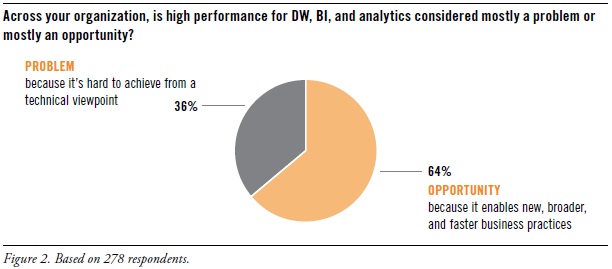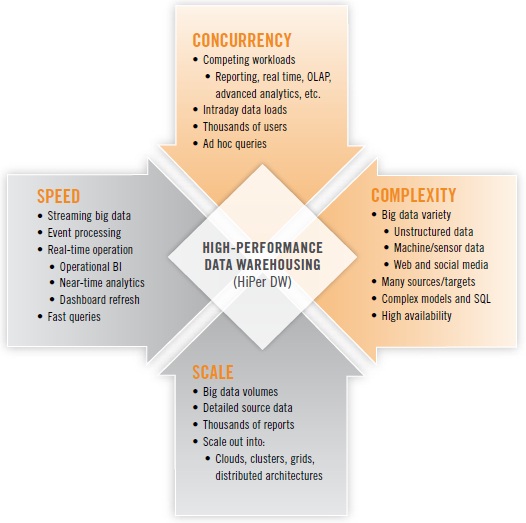By Philip Russom, TDWI Research Director
[NOTE -- My new TDWI report about High-Performance Data Warehousing (HiPer DW) is finished and will be published in October. The report’s Webinar will broadcast on October 9, 2012. In the meantime, I’ll leak a few of the report’s findings in this blog series. Search Twitter for #HiPerDW to find other leaks. Enjoy!]

In recent years, TDWI has seen many user organizations adopt new vendor platforms and user best practices, which helped overcome some of the performance issues that dogged them for years, especial data volume scalability and real-time data movement for operational BI. With that progress in mind, a TDWI survey asked: “Across your organization, is high performance for DW, BI, and analytics considered mostly a problem or mostly an opportunity?” (See Figure 2, shown above.)
Two thirds (64%) consider high performance an opportunity. This positive assessment isn’t surprising, given the success of real-time practices like operational BI. Similarly, many user organizations have turned the corner on big data, no longer struggling to merely manage it, but instead leveraging its valuable information through exploratory or predictive analytics, to discover new facts about customers, markets, partners, costs, and operations.
Only a third (36%) consider high performance a problem. Unfortunately, some organizations still struggle to meet user expectations and service level agreements for queries, cubes, reports, and analytic workloads. Data volume alone is a show stopper for some organizations. Common performance bottlenecks center on loading large data volumes into a data warehouse, running reports that involve complex table joins, and presenting time-sensitive data to business managers.
BENEFITS OF HIGH-PERFORMANCE DATA WAREHOUSING
Analytic methods are the primary beneficiaries of high performance. Advanced analytics (mining, statistics, complex SQL; 62%) and big data for analytics (40%) top the list of practices most likely to benefit from high performance, with basic analysis (OLAP and its variants; 26%) not too far down the list. High performance is critical for analytic methods because they demand hefty system resources, they are evolving toward real-time response, and they are a rising priority for business users.
Real-time BI practices are also key beneficiaries of HiPer DW. High performance can assist practices that include a number of real-time functions, including operational business intelligence (37%), dashboards and performance management (34%), operational analytics (30%), and automated decisions for real-time processes (25%). Don’t forget: the incremental movement toward real-time operation is the most influential trend in BI today, in that it affects every layer of the BI/DW/DI and analytics technology stack, plus user practices.
System performance can contribute to business processes that rely on data or BI/DW/DI infrastructure. These include business decisions and strategies (33%), customer experience and service (21%), business performance and execution (19%), and data-driven corporate objectives (14%).
Enterprise business intelligence (EBI) needs all the performance help it can get. By definition, EBI involves thousands of users (most of them concurrent) and tens of thousands of reports (most refreshed on a 24-hour cycle). Given its size and complexity, EBI can be a performance problem. Yet, survey respondents don’t seem that concerned about EBI, with few respondents selecting EBI issues, such as standard reports (15%), supporting thousands of concurrent users (15%), and refreshing thousands of reports (12%).
Want more? Register for my HiPer DW Webinar, coming up Oct.9 noon ET.
Read other blogs in this series:
The Four Dimensions of HiPer DW
Defining HiPer DW
High Performance: The Secret of Success and Survival
Posted by Philip Russom, Ph.D. on September 21, 20120 comments
By Philip Russom, TDWI Research Director
[NOTE -- My new TDWI report about High-Performance Data Warehousing (HiPer DW) is finished and will be published in October. The report’s Webinar will broadcast on October 9, 2013. In the meantime, I’ll leak a few of the report’s findings in this blog series. Search Twitter for #HiPerDW to find other leaks. Enjoy!]
FIGURE 1.

More
Posted on September 14, 20120 comments
By Philip Russom, TDWI Research Director
[
NOTE
-- My new TDWI report about High-Performance Data Warehousing (HiPer DW) is finished and will be published in October. The report’s Webinar will broadcast on October 9, 2013. In the meantime, I’ll leak a few of the report’s findings in this blog series. Search Twitter for #HiPerDW to find other leaks. Enjoy!]
Data used to be just data. Now there’s big data, real-time data, multi-structured data, analytic data, and machine data. Likewise, user communities have swollen into thousands of concurrent users, reports, dashboards, scorecards, and analyses. The rising popularity of advanced analytics has driven up the number of power users, with their titanic ad hoc queries and analytic workloads. And there are still brave new worlds to explore, such as social media and sensor data.
More
Posted by Philip Russom, Ph.D. on September 7, 20120 comments
Business decision cycles are turning faster, and to keep up, executives and managers are in constant need of new data and new types of reporting and analysis. Dynamic organizations are demanding greater agility from their business intelligence (BI) systems. TDWI Research is currently examining how well organizations are able to adjust their BI and data warehouse (DW) development, deployment, and management to enable greater agility.
How is your organization doing in addressing user demands for more agile BI/DW? What are your toughest challenges? We would very much like to include your opinions and insights in the TDWI Research survey, which is live right now. Thank you to everyone who has already participated in the survey. As part of my research for what will ultimately be a TDWI Best Practices Report, I am also conducting interviews with professionals to understand their experiences with agile development methods for BI/DW and with deploying self-service BI, data virtualization, and other technologies that are helping organizations become more agile. If you are interested, please drop me a line at [email protected].
More
Posted by David Stodder on August 27, 20120 comments
Personal, self-service analytics and discovery is one of the most important trends not only in business intelligence (BI) but in user applications generally. Expensive, monster systems that have big footprints and are not flexible to meet dynamic business needs are increasingly viewed by users as legacy. Rather than work with monolithic, one-size-fits-all applications that are dominated by IT management and development, users today want freedom and agility. They do not want to wait weeks or months for changes; they want to tailor reporting, analysis, and data sharing to their immediate and often changing needs.
More
Posted by David Stodder on June 28, 20120 comments
At the recently concluded TDWI Solution Summit on big data analytics in San Diego, a discussion topic that percolated throughout the conference was the increasing role in IT purchases of the marketing function and chief marketing officers (CMOs). During a question-and-answer period, an attendee asked sponsor panel speakers for comment about a January 2012 projection by Gartner research vice president Laura McLellan that by 2017, CMOs will spend more on IT than CIOs. Though impressed by the projection, the panelists did not seem surprised by this trend.
More
Posted by David Stodder on June 18, 20120 comments